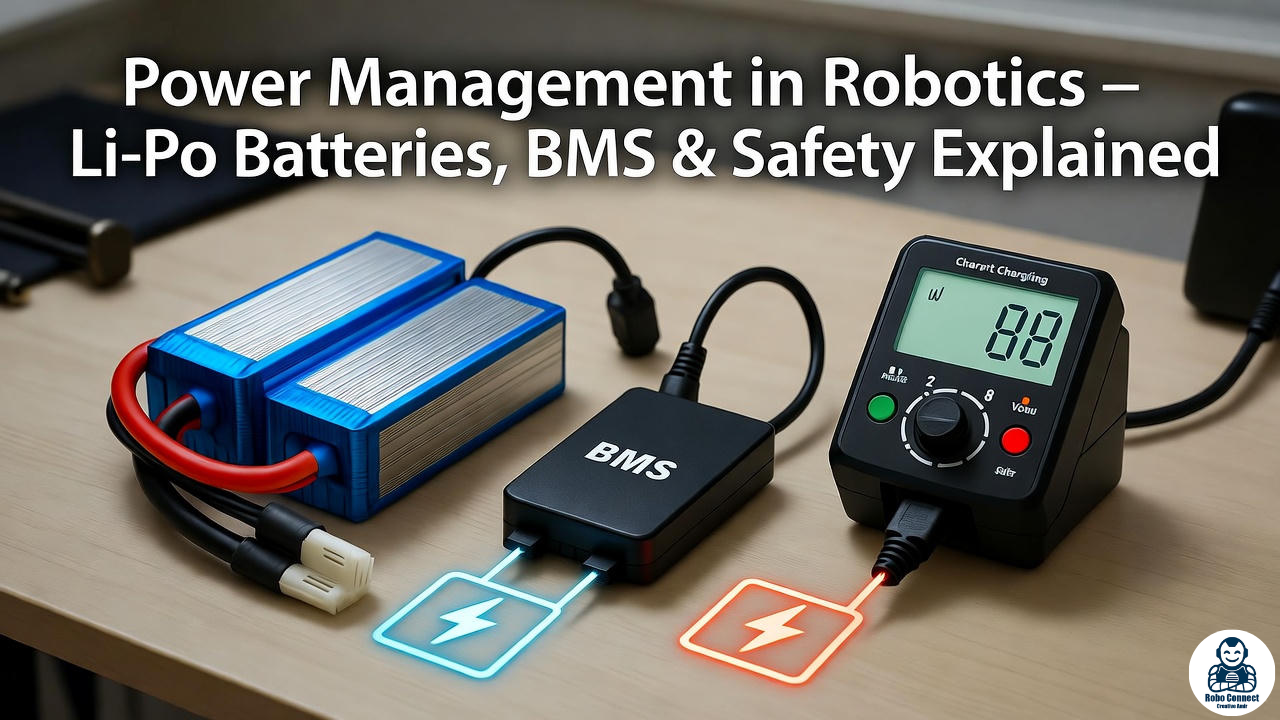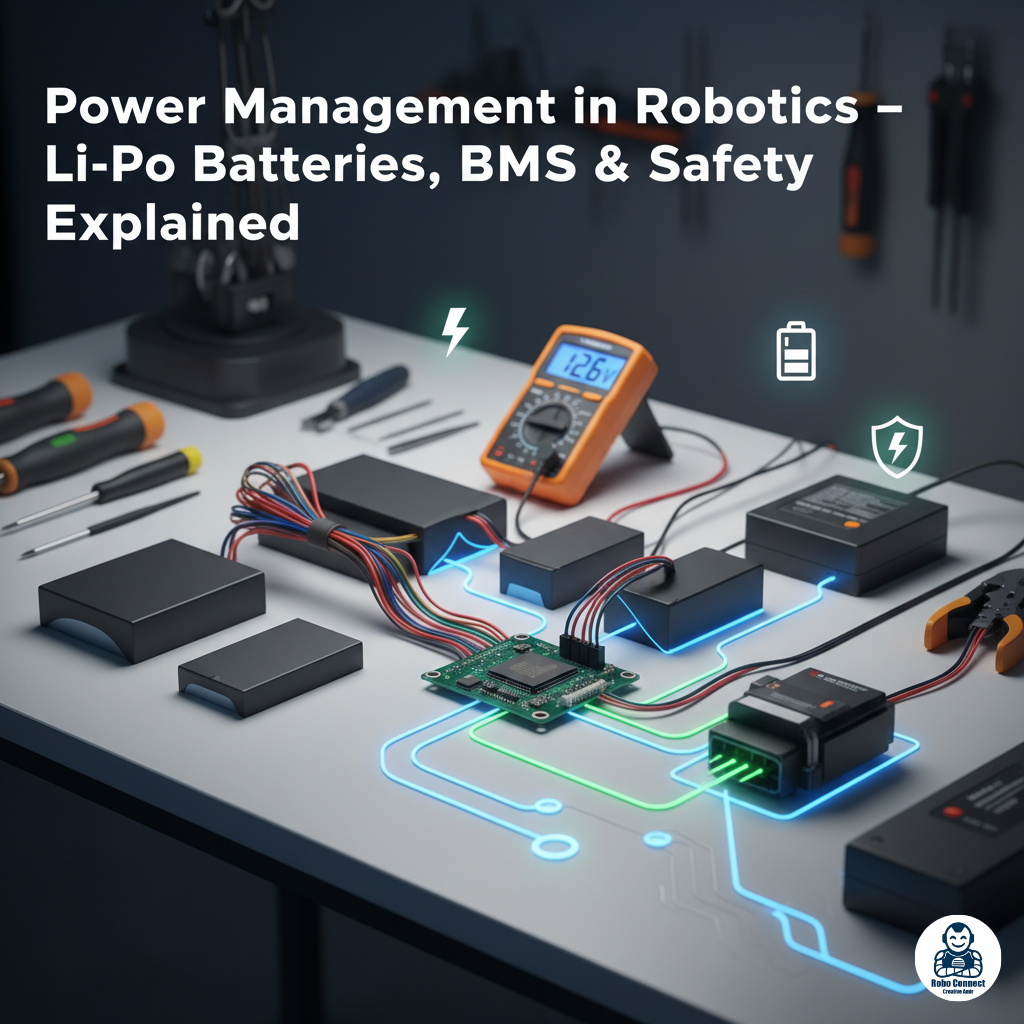Introduction
Every robot needs a brain (microcontroller), muscles (motors/servos), and senses (sensors). But none of that works without a good power system .
Poor power management causes:
- Motors underperforming / stalling.
- Controllers resetting mid‑run.
- Worst: Batteries overheating or even catching fire.
This guide breaks it down:
- Types of batteries in robotics.
- Why Li‑Po batteries are widely used.
- What a BMS (Battery Management System) is.
- Beginner do’s & don’ts for safe robot power design.
Battery Options for Robotics
- Alkaline (AA/AAA cells)
- Good only for beginner LED/sensor circuits.
- Weak for motors.
- Not rechargeable → expensive long term.
- NiMH Rechargeable Packs
- Cheaper RC/toy robots.
- Safe, but lower energy density.
- Lithium‑Ion (18650 cells)
- Cylindrical laptop‑style Li‑ion cells.
- High capacity + recharge cycles.
- Common in EVs & robotics power packs.
- Li‑Po (Lithium‑Polymer) Packs (Most Popular for DIY Robotics)
- High energy density → lots of power in small size.
- Can deliver very high discharge currents → ideal for motors/servos.
- Available in many sizes (7.4V 2S, 11.1V 3S, etc.).
Why Robots Use Li‑Po Batteries
- Lightweight + compact (perfect for drones, smart cars).
- High discharge rate (C‑rating): Motors need bursts of current → Li‑Po handles it.
- Rechargeable 300–500+ cycles.
- Available in wide voltages → fits Arduinos (5V), servos (6V), motors (12V).
But caution: Li‑Po packs are sensitive and need careful handling.
Understanding Li‑Po Battery Ratings
Example: 3S 2200mAh 25C
- 3S: 3 cells in series → ~11.1V (Nominal).
- 2200mAh: Capacity → battery can deliver 2200mA for 1 hour.
- 25C: Discharge rate → 25 × 2.2A = 55A max continuous current.
Picking a battery with proper C rating = ensures your motors get the current they need.
What is a BMS (Battery Management System)?
A BMS monitors and protects the battery pack:
- Overcharge Protection → stops charging above safe voltage.
- Over‑discharge Protection → prevents cells dropping below safe cutoff.
- Cell Balancing → ensures all cells in multi‑cell packs stay equal.
- Short Circuit/Overcurrent Protection.
Think of BMS as a safety guardian for batteries → must‑have for robotics projects you want to last.
Power Distribution in Robotics
Robots usually have:
- 1 main battery pack (Li‑Po or Li‑ion).
- Power split via:
- 5V regulator → microcontrollers (Arduino, ESP, Pi).
- 6V → Servos.
- 12V → DC motors.
Voltage Regulators (buck converters) are often used:
- Example: Step‑down modules (LM2596, XL6009).
- Efficiently reduce 12V Li‑Po → 5V or 6V as needed.
Beginner Power Tips (Do’s & Don’ts)
Do’s:
- Use Li‑Po safe chargers (balance chargers like iMAX B6).
- Store Li‑Po at ~3.8V/cell (storage voltage).
- Add a fuse or protection circuit for high‑amp robots.
- Mount batteries securely → avoid vibrations.
Don’ts:
- Never overcharge (4.2V/cell max).
- Never discharge below ~3.2V/cell.
- Do not puncture, short circuit, or crush Li‑Po.
- Don’t leave charging unattended.
FAQs
Q1: Can I power Arduino directly from Li‑Po?
Yes (through VIN or regulator) — but better to use a buck converter for stable 5V.
Q2: Are Li‑ion safer than Li‑Po?
Generally yes, but Li‑Po gives higher current output → preferred for robotics.
Q3: Why not just use power banks?
Power banks (5V USB) work only for microcontrollers, not motors/servos with higher current draw.
Conclusion
In robotics, power is everything. A great design fails if motors brown out or controllers reset.
- Li‑Po batteries → best for DIY robots (light + powerful).
- BMS → safety + long life.
- Proper power distribution → stable controllers, strong motors.
Mastering power management = making robots reliable instead of fragile.

